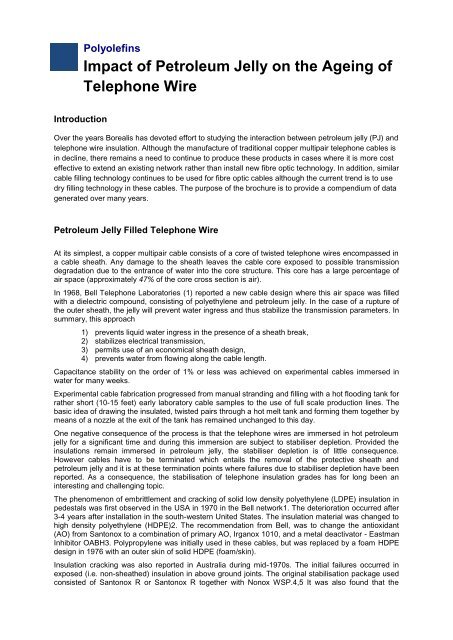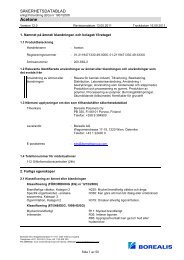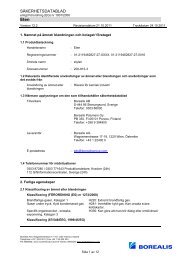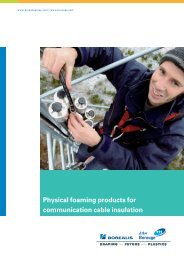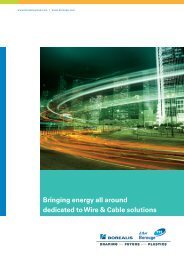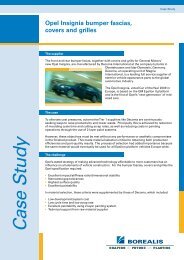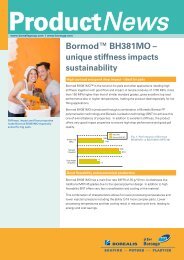Impact of Petroleum Jelly on the Ageing of Telephone Wire - Borealis
Impact of Petroleum Jelly on the Ageing of Telephone Wire - Borealis
Impact of Petroleum Jelly on the Ageing of Telephone Wire - Borealis
You also want an ePaper? Increase the reach of your titles
YUMPU automatically turns print PDFs into web optimized ePapers that Google loves.
Introducti<strong>on</strong><br />
Polyolefins<br />
<str<strong>on</strong>g>Impact</str<strong>on</strong>g> <str<strong>on</strong>g>of</str<strong>on</strong>g> <str<strong>on</strong>g>Petroleum</str<strong>on</strong>g> <str<strong>on</strong>g>Jelly</str<strong>on</strong>g> <strong>on</strong> <strong>the</strong> <strong>Ageing</strong> <str<strong>on</strong>g>of</str<strong>on</strong>g><br />
Teleph<strong>on</strong>e <strong>Wire</strong><br />
Over <strong>the</strong> years <strong>Borealis</strong> has devoted effort to studying <strong>the</strong> interacti<strong>on</strong> between petroleum jelly (PJ) and<br />
teleph<strong>on</strong>e wire insulati<strong>on</strong>. Although <strong>the</strong> manufacture <str<strong>on</strong>g>of</str<strong>on</strong>g> traditi<strong>on</strong>al copper multipair teleph<strong>on</strong>e cables is<br />
in decline, <strong>the</strong>re remains a need to c<strong>on</strong>tinue to produce <strong>the</strong>se products in cases where it is more cost<br />
effective to extend an existing network ra<strong>the</strong>r than install new fibre optic technology. In additi<strong>on</strong>, similar<br />
cable filling technology c<strong>on</strong>tinues to be used for fibre optic cables although <strong>the</strong> current trend is to use<br />
dry filling technology in <strong>the</strong>se cables. The purpose <str<strong>on</strong>g>of</str<strong>on</strong>g> <strong>the</strong> brochure is to provide a compendium <str<strong>on</strong>g>of</str<strong>on</strong>g> data<br />
generated over many years.<br />
<str<strong>on</strong>g>Petroleum</str<strong>on</strong>g> <str<strong>on</strong>g>Jelly</str<strong>on</strong>g> Filled Teleph<strong>on</strong>e <strong>Wire</strong><br />
At its simplest, a copper multipair cable c<strong>on</strong>sists <str<strong>on</strong>g>of</str<strong>on</strong>g> a core <str<strong>on</strong>g>of</str<strong>on</strong>g> twisted teleph<strong>on</strong>e wires encompassed in<br />
a cable sheath. Any damage to <strong>the</strong> sheath leaves <strong>the</strong> cable core exposed to possible transmissi<strong>on</strong><br />
degradati<strong>on</strong> due to <strong>the</strong> entrance <str<strong>on</strong>g>of</str<strong>on</strong>g> water into <strong>the</strong> core structure. This core has a large percentage <str<strong>on</strong>g>of</str<strong>on</strong>g><br />
air space (approximately 47% <str<strong>on</strong>g>of</str<strong>on</strong>g> <strong>the</strong> core cross secti<strong>on</strong> is air).<br />
In 1968, Bell Teleph<strong>on</strong>e Laboratories (1) reported a new cable design where this air space was filled<br />
with a dielectric compound, c<strong>on</strong>sisting <str<strong>on</strong>g>of</str<strong>on</strong>g> polyethylene and petroleum jelly. In <strong>the</strong> case <str<strong>on</strong>g>of</str<strong>on</strong>g> a rupture <str<strong>on</strong>g>of</str<strong>on</strong>g><br />
<strong>the</strong> outer sheath, <strong>the</strong> jelly will prevent water ingress and thus stabilize <strong>the</strong> transmissi<strong>on</strong> parameters. In<br />
summary, this approach<br />
1) prevents liquid water ingress in <strong>the</strong> presence <str<strong>on</strong>g>of</str<strong>on</strong>g> a sheath break,<br />
2) stabilizes electrical transmissi<strong>on</strong>,<br />
3) permits use <str<strong>on</strong>g>of</str<strong>on</strong>g> an ec<strong>on</strong>omical sheath design,<br />
4) prevents water from flowing al<strong>on</strong>g <strong>the</strong> cable length.<br />
Capacitance stability <strong>on</strong> <strong>the</strong> order <str<strong>on</strong>g>of</str<strong>on</strong>g> 1% or less was achieved <strong>on</strong> experimental cables immersed in<br />
water for many weeks.<br />
Experimental cable fabricati<strong>on</strong> progressed from manual stranding and filling with a hot flooding tank for<br />
ra<strong>the</strong>r short (10-15 feet) early laboratory cable samples to <strong>the</strong> use <str<strong>on</strong>g>of</str<strong>on</strong>g> full scale producti<strong>on</strong> lines. The<br />
basic idea <str<strong>on</strong>g>of</str<strong>on</strong>g> drawing <strong>the</strong> insulated, twisted pairs through a hot melt tank and forming <strong>the</strong>m toge<strong>the</strong>r by<br />
means <str<strong>on</strong>g>of</str<strong>on</strong>g> a nozzle at <strong>the</strong> exit <str<strong>on</strong>g>of</str<strong>on</strong>g> <strong>the</strong> tank has remained unchanged to this day.<br />
One negative c<strong>on</strong>sequence <str<strong>on</strong>g>of</str<strong>on</strong>g> <strong>the</strong> process is that <strong>the</strong> teleph<strong>on</strong>e wires are immersed in hot petroleum<br />
jelly for a significant time and during this immersi<strong>on</strong> are subject to stabiliser depleti<strong>on</strong>. Provided <strong>the</strong><br />
insulati<strong>on</strong>s remain immersed in petroleum jelly, <strong>the</strong> stabiliser depleti<strong>on</strong> is <str<strong>on</strong>g>of</str<strong>on</strong>g> little c<strong>on</strong>sequence.<br />
However cables have to be terminated which entails <strong>the</strong> removal <str<strong>on</strong>g>of</str<strong>on</strong>g> <strong>the</strong> protective sheath and<br />
petroleum jelly and it is at <strong>the</strong>se terminati<strong>on</strong> points where failures due to stabiliser depleti<strong>on</strong> have been<br />
reported. As a c<strong>on</strong>sequence, <strong>the</strong> stabilisati<strong>on</strong> <str<strong>on</strong>g>of</str<strong>on</strong>g> teleph<strong>on</strong>e insulati<strong>on</strong> grades has for l<strong>on</strong>g been an<br />
interesting and challenging topic.<br />
The phenomen<strong>on</strong> <str<strong>on</strong>g>of</str<strong>on</strong>g> embrittlement and cracking <str<strong>on</strong>g>of</str<strong>on</strong>g> solid low density polyethylene (LDPE) insulati<strong>on</strong> in<br />
pedestals was first observed in <strong>the</strong> USA in 1970 in <strong>the</strong> Bell network1. The deteriorati<strong>on</strong> occurred after<br />
3-4 years after installati<strong>on</strong> in <strong>the</strong> south-western United States. The insulati<strong>on</strong> material was changed to<br />
high density polyethylene (HDPE)2. The recommendati<strong>on</strong> from Bell, was to change <strong>the</strong> antioxidant<br />
(AO) from Sant<strong>on</strong>ox to a combinati<strong>on</strong> <str<strong>on</strong>g>of</str<strong>on</strong>g> primary AO, Irganox 1010, and a metal deactivator - Eastman<br />
Inhibitor OABH3. Polypropylene was initially used in <strong>the</strong>se cables, but was replaced by a foam HDPE<br />
design in 1976 with an outer skin <str<strong>on</strong>g>of</str<strong>on</strong>g> solid HDPE (foam/skin).<br />
Insulati<strong>on</strong> cracking was also reported in Australia during mid-1970s. The initial failures occurred in<br />
exposed (i.e. n<strong>on</strong>-shea<strong>the</strong>d) insulati<strong>on</strong> in above ground joints. The original stabilisati<strong>on</strong> package used<br />
c<strong>on</strong>sisted <str<strong>on</strong>g>of</str<strong>on</strong>g> Sant<strong>on</strong>ox R or Sant<strong>on</strong>ox R toge<strong>the</strong>r with N<strong>on</strong>ox WSP.4,5 It was also found that <strong>the</strong>
oxidati<strong>on</strong> process was accelerated by <strong>the</strong> presence <str<strong>on</strong>g>of</str<strong>on</strong>g> titanium dioxide (TiO2). Many colour pigments<br />
c<strong>on</strong>tain TiO2.<br />
The stabilisati<strong>on</strong> package for <strong>the</strong> HDPE insulati<strong>on</strong> compounds has evolved over <strong>the</strong> years to include a<br />
primary antioxidant with a metal deactivator. The current antioxidant package generally used, in USA<br />
and Europe, c<strong>on</strong>sists <str<strong>on</strong>g>of</str<strong>on</strong>g> a phenolic antioxidant, Irganox 1010 and a bi-functi<strong>on</strong>al (antioxidant combined<br />
with metal deactivator) stabiliser, Irganox MD 1024.6 The combinati<strong>on</strong> <str<strong>on</strong>g>of</str<strong>on</strong>g> Irganox 1010 and Eastman<br />
OABH is used in Australia.<br />
Standards<br />
This system vulnerability has been recognised and tests to explore <strong>the</strong> interacti<strong>on</strong> <str<strong>on</strong>g>of</str<strong>on</strong>g> petroleum jelly<br />
with teleph<strong>on</strong>e wires have been standardised. Within <strong>Borealis</strong> we have focused <strong>on</strong> 3 standards:<br />
EN50407 which makes reference to EN50290-2-23/EN60811-4-2<br />
British Telecommunicati<strong>on</strong>s BTM 142<br />
Bellcore TR-NWT-000421<br />
Table 1. Interacti<strong>on</strong> <str<strong>on</strong>g>Petroleum</str<strong>on</strong>g> <str<strong>on</strong>g>Jelly</str<strong>on</strong>g> with Insulated Teleph<strong>on</strong>e <strong>Wire</strong><br />
Test BTM 142 EN50290-2-23 EN60811-4-2<br />
Bellcore TR-<br />
NWT-000421<br />
Pre-treatment in<br />
<str<strong>on</strong>g>Petroleum</str<strong>on</strong>g> <str<strong>on</strong>g>Jelly</str<strong>on</strong>g> (PJ)<br />
14 days, 60°C<br />
7*/10 days,<br />
60/70°C**<br />
7*/10 days,<br />
60/70°C**<br />
28 days, 70°C<br />
Weight gain < 15% < 15/18% See cable spec. na<br />
Mechanical<br />
properties<br />
Pig tail sample.<br />
Retained yield<br />
stress >85%<br />
El<strong>on</strong>gati<strong>on</strong><br />
>100%<br />
na na<br />
Age 1 day, 70°C.<br />
Visual inspecti<strong>on</strong><br />
na No cracks No cracks na<br />
L<strong>on</strong>g term stability 21 days, 105°C<br />
42days<br />
100/105°C<br />
42days<br />
100/105°C<br />
260 days, 90°C<br />
Visual inspecti<strong>on</strong><br />
for cracking<br />
No cracks No cracks No cracks No cracks<br />
Weight gain < 1mg/2m 100(foam)/<br />
200(solid)%<br />
na<br />
Pig tail test.<br />
Visual inspecti<strong>on</strong><br />
No cracks No cracks<br />
Fast test na na na<br />
PJ pre-treatment<br />
14 days, 70°C<br />
Retained OIT<br />
>50% <str<strong>on</strong>g>of</str<strong>on</strong>g> initial<br />
200°C, 28days<br />
(>60min)<br />
Retained OIT<br />
>35% <str<strong>on</strong>g>of</str<strong>on</strong>g> initial<br />
200°C, 56days<br />
(>60min)<br />
Notes * Pre-treatment temperature for l<strong>on</strong>g term stability test<br />
** 60°C for PJ with drop point 50-70°C, 70°C for PJ with drop point >70°C<br />
EN60811-4-2 refers to two ageing temperatures (100°C for c<strong>on</strong>diti<strong>on</strong>ing complete cables and two<br />
classes <str<strong>on</strong>g>of</str<strong>on</strong>g> performance (100 and 105°C) for <strong>the</strong> l<strong>on</strong>g term stability <str<strong>on</strong>g>of</str<strong>on</strong>g> insulated c<strong>on</strong>ductors. Although<br />
2
<strong>the</strong> test methods differ in detail, all c<strong>on</strong>sist <str<strong>on</strong>g>of</str<strong>on</strong>g> a petroleum jelly pre-treatment at elevated temperature<br />
(to simulate <strong>the</strong> manufacturing process) followed by removal <str<strong>on</strong>g>of</str<strong>on</strong>g> <strong>the</strong> petroleum jelly and oven ageing <str<strong>on</strong>g>of</str<strong>on</strong>g><br />
<strong>the</strong> insulated wires (to correlate with <strong>the</strong> life expectancy after installati<strong>on</strong>).<br />
Products<br />
Over <strong>the</strong> years a number <str<strong>on</strong>g>of</str<strong>on</strong>g> petroleum jelly products have been evaluated in combinati<strong>on</strong> with<br />
<strong>Borealis</strong>’ telecommunicati<strong>on</strong> grades (Table 2). Insojell 2332 is a very comm<strong>on</strong> petroleum jelly, based<br />
<strong>on</strong> mineral oil, used in telecommunicati<strong>on</strong> and included here as a reference. Waterguard, being a<br />
thixotrope, inherently resists flow at elevated temperatures, hence providing a drip free cable at<br />
temperatures greatly in excess <str<strong>on</strong>g>of</str<strong>on</strong>g> <strong>the</strong> current 80°C requirement. Waterguard P90 is designed as a<br />
waterpro<str<strong>on</strong>g>of</str<strong>on</strong>g> copper cable filling compound.<br />
Table 2. Filling Compounds<br />
Producer Trade name Applicati<strong>on</strong> Type <str<strong>on</strong>g>of</str<strong>on</strong>g> FC<br />
Dussek<br />
Campbell<br />
Insojell 2332 CuMP Mineral oils, Td = 75°C<br />
Dussek<br />
Campbell<br />
Insojell 5116 CuMP Poly-isobutene, Td = 105°C<br />
Caschem Bufferite<br />
M1<br />
117- FOC Polypropylene glycol (polar)*, Td > 343°C<br />
Seppic Sepigel<br />
OF300SF<br />
FOC Polyalphaolefin*, Td > 200°C<br />
Waterguard P90 CuMP Mixture <str<strong>on</strong>g>of</str<strong>on</strong>g> mineral oils - syn<strong>the</strong>tic*<br />
Witco Witcogel<br />
TCV 910<br />
KBELFILL<br />
6200<br />
II /<br />
* thixotropic, Td = drop point<br />
FOC ETPR*, Td > 196°C<br />
Bufferite 117-M1 is targeted as filling compounds for fibre optic cables (FOC) like loose tube, central<br />
tube and slotted core. The Bufferite 117 series are highly purified, n<strong>on</strong>-melting, thixotropic gels which<br />
can be extruded at temperatures up to 270°C. They are claimed to be compatible with a wide range <str<strong>on</strong>g>of</str<strong>on</strong>g><br />
fibre coatings, inks and tube c<strong>on</strong>structi<strong>on</strong> materials, including PBT, PA12, PP and PP/PE copolymers.<br />
Bufferite 117 is based <strong>on</strong> a polyol fluid, stabilised with a hindered phenolic antioxidant. Sepigel OF300<br />
SF is a filling compound specifically developed for use in FOC. It is manufactured from syn<strong>the</strong>tic<br />
aliphatic hydrocarb<strong>on</strong>s. Witcogel II/TCV 910 is based <strong>on</strong> extended <strong>the</strong>rmoplastic rubber, ETPR<br />
Table 3. Insulati<strong>on</strong> Compounds.<br />
Grade Applicati<strong>on</strong> Skin Sample<br />
ME1244 MDPE cellular ME6032 <strong>Wire</strong> 0,5 x 0,9mm (skin 0,05mm)<br />
ME1244 MDPE cellular HE3366 <strong>Wire</strong> 0,5 x 0,9mm (skin 0,05mm)<br />
HE1344 HDPE cellular HE3366 <strong>Wire</strong> 0,5 x 0,9mm (skin 0,05mm)<br />
ME1244 MDPE cellular N<strong>on</strong>e <strong>Wire</strong> 0,5 x 0,9mm<br />
HE1344 HDPE cellular N<strong>on</strong>e <strong>Wire</strong> 0,5 x 0,9mm<br />
HE1345 HDPE cellular +<br />
enhanced stabilisati<strong>on</strong><br />
N<strong>on</strong>e<br />
ME6032 MDPE solid N<strong>on</strong>e <strong>Wire</strong> 0,5 x 0,8mm<br />
HE3366 HDPE solid N<strong>on</strong>e <strong>Wire</strong> 0,5 x 0,8mm<br />
HE3368 HDPE solid + enhanced<br />
stabilisati<strong>on</strong><br />
HE1110 HDPE slotted core<br />
(FOC)<br />
Plaque 1,5mm<br />
3
The telecommunicati<strong>on</strong> grades tested are shown (Table 3). As <strong>the</strong>se tests have been completed over<br />
many years <strong>the</strong>re may be some minor variati<strong>on</strong>s in <strong>the</strong> product tested. However for <strong>the</strong> grades noted,<br />
<strong>the</strong> basic properties and additive package are totally c<strong>on</strong>sistent.<br />
Results<br />
a) EN60811-4-2 test data<br />
Table 4. Absorpti<strong>on</strong> <str<strong>on</strong>g>of</str<strong>on</strong>g> Filling Compounds (70°C, 10 days) into <strong>Wire</strong>s.<br />
%<br />
80<br />
70<br />
60<br />
50<br />
40<br />
30<br />
20<br />
10<br />
0<br />
-10<br />
ME1244/ ME1244/ HE1344/ ME1244 HE1344 ME6032 HE3366<br />
ME6032 HE3366 HE3366<br />
Insojell2332 10,36 12,14 9,45 15,35 72 8,71 9,16<br />
Insojell5116 5,44 3,22 11,28 7,86 48,13 6,08 5,26<br />
Bufferite 117-M1 -2,27 -1,54 -0,77 0,27 33,65 -1,7 -0,5<br />
Sepigel OF00SF 7,71 4,83 5,64 9,49 36,19 1,7 4,26<br />
Waterguard P90 14,06 11,33 12 42,82 39,37 6,06 8,9<br />
Witcogel ll<br />
TCV910<br />
14,4 23,4 17,36 16,96 66,35 6,94 11,78<br />
4<br />
Witcogel II TCV910<br />
Waterguard P90<br />
Sepigel OF300SF<br />
Bufferite 117-M1<br />
Insojell5116<br />
Insojell2332
Table 5. OIT/Pigtails after Different Treatments.<br />
Sample 0-test FC 70°C/7d<br />
<strong>Wire</strong><br />
Insojell 2332 Insojell 5116 Bufferite 117-M1<br />
Air<br />
105°C/42d<br />
Pigtails (OIT/min),<br />
vis. FC70°C/7d 105°C/42d<br />
5<br />
Pigtails (OIT/min),<br />
vis. FC70°C/7d 105°C/42d<br />
OIT/min OIT/min OIT/min 60°C/ 7 d OIT/min OIT/min 60°C/ 7 d OIT/min OIT/min 60°C/ 7 d<br />
Pigtails (OIT/min),<br />
vis.<br />
ME1244/ME6032 138 30 12 8/OK 24 12 13/OK 114 6 degr.<br />
ME1244/HE3366 175 54 21 8/OK 46 23 23/OK 176 13 degr.<br />
HE1344/HE3366 164 37 12 8/OK 28 8 7/OK 162 4 degr.<br />
ME1244 164 26 10 8/OK 27 25 18/OK 135 4 degr.<br />
HE1344 135 4 < 1
) Bellcore TR-NWT-00421 (Pedestal Test)<br />
Seven different coloured commercially produced teleph<strong>on</strong>e wires insulated with HE1345 have been<br />
aged according to <strong>the</strong> Bellcore test method. The petroleum jelly used was KBELFIL 6200. For <strong>the</strong><br />
purposes <str<strong>on</strong>g>of</str<strong>on</strong>g> this report, <strong>the</strong> results have been averaged.<br />
Table 6. Fast Test.<br />
Initial<br />
Pre-treated<br />
14 days at 70°C<br />
6<br />
Aged<br />
28 days at 90°C<br />
OIT 200°C 271 min 151 min (>60min) 108 min 83 min<br />
Aged<br />
56 days at 90°C<br />
Retained 56% 71% (>50%) 55% (>35%)<br />
Note. Requirements shown in brackets.<br />
Table 7. Standard Test<br />
Pre-treated<br />
Aged<br />
Aged<br />
28days at 70°C 260days at 90°C 280days at 90°C<br />
Cracks NA 3/30 (max 3)<br />
Cracks (%) 10% (max 10%)<br />
Note. Requirements shown in brackets.<br />
The results indicate that <strong>the</strong> insulati<strong>on</strong>s met comfortably <strong>the</strong> requirements <str<strong>on</strong>g>of</str<strong>on</strong>g> <strong>the</strong> fast test but were<br />
marginal for <strong>the</strong> standard test.<br />
Discussi<strong>on</strong> <str<strong>on</strong>g>of</str<strong>on</strong>g> Results<br />
<strong>Ageing</strong> performance is a challenging combinati<strong>on</strong> <str<strong>on</strong>g>of</str<strong>on</strong>g> material properties, cable design and<br />
manufacturing process. The results presented are indicative but cable makers must make tests <strong>on</strong><br />
products produced in <strong>the</strong>ir own manufacturing facilities to ensure compliance with specific test<br />
standards.<br />
References<br />
I. Biakeborn, MAC et al., Proc. 17 th IWCS, Atlantic City, New Jersey, Dec 1968<br />
II. Pusey, BB., Chen, MT. and Roberts, Proc. Int. <strong>Wire</strong> & Cable Symp. (1971) 209-217.<br />
III. Bowmer, TN, Proc. Int. <strong>Wire</strong> & Cable Symp. (1988) 475- 483.<br />
IV. Gilroy, HM., Proc. Int. <strong>Wire</strong> & Cable Symp. (1974) 42-45.<br />
V. Board, BL. and Ruddell, HJ. Proc. Int. <strong>Wire</strong> & Cable Symp. 1982, 300-312.<br />
VI. Ruddell, HJ., Adams, DJ. and Chisholm, BA., A.T.R. Vol. 16 (1982) No. 2, 57-72.<br />
VII. Gau. Y., Nels<strong>on</strong>, ED. and Dye, KD. Int. <strong>Wire</strong> & Cable Symp. (1992) 298-303.


